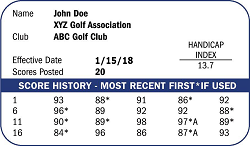Section 6 SCORING RECORDS
Definitions
Within each section, all defined terms are in italics and are listed alphabetically in Section 2 - Definitions.
Scores made in a new playing season (or calendar year) must be added to those of the preceding playing seasons (or calendar years) to make up a scoring record. Scoring records must be maintained continuously from year to year. (See Decision 6-1/1.)
The Authorized Golf Association having jurisdiction in an area is responsible for declaring the duration of any inactive season. A golf club located within the area covered by an Authorized Golf Association must observe any inactive season established by the Authorized Golf Association, even if the club is not a member of the association. (See Decision 6-2/1.)
Scores made at any golf course observing an inactive season are not acceptable for handicap purposes. Scores made at a golf course in an area observing an active season must be posted for handicap purposes, even if the golf club from which the player receives a Handicap Index is observing an inactive season. The club's Handicap Committee must make it possible for a player to post these away scores prior to the next Handicap Index revision.
Example: If a player belonging to a golf club in Michigan plays golf in Florida during January, any scores made in Florida are acceptable and must be returned to the player's Michigan golf club. If the player is also a member of a golf club in Florida, scores must be posted to the player's Florida club.
The accessibility of scoring records is an important component of peer review. Accordingly, the club must provide the ability to view the scoring records of all members that includes the last 20 scores (fewer if the scoring record has fewer than 20 scores), plus any eligible tournament scores. This information must be readily available for inspection by fellow members and others. (See Decisions 6-3/1 and 6-3/2.)
Every player may be issued a handicap card or label that can be affixed to a card on which the player's Handicap Index is recorded. Handicaps on cards issued by an Authorized Golf Association or a golf club that follows the USGA Handicap System must be identified as a Handicap Index. The name of the golf club or Authorized Golf Association issuing the Handicap Index must be displayed on such cards and labels. If the name of the computation service appears on the card, it must be no more than 1/4 inch in height and must be smaller than the identification of the issuing authority.

A player who belongs to more than one golf club must do either of the following:
(a) Register as a multi-member with the Authorized Golf Association or computation service, if such service is provided, so that all scores at every club will enter into the player's scoring record for computation; or
(b) Return all scores to all clubs in person, or by e-mail, fax, Internet, or surface mail (See Section 5-2), together with the USGA Course Rating and Slope Rating, and date.
If a player maintains a Handicap Index at more than one club, and the clubs do not use a networked computation service, all acceptable scores must be posted at all clubs. (See Decision 6-5/1.) This will result in the same Handicap Index at all clubs unless there are administrative problems such as transmission problems or mailing delays. Failure to post all acceptable scores at all clubs produces a Handicap Index that is not based on the player's best 10 Handicap Differentials of the last 20 scores and consequently may not be termed a Handicap Index. If a player has a different Handicap Index at different clubs, despite posting all scores at all clubs, the Committee in charge of the competition may require the player to use the lowest Handicap Index when competing with players from more than one club. (See Decision 6-5/3.)
When changing golf clubs, a player should give the new club a record of the last 20 scores in chronological order plus any eligible tournament scores recorded with the appropriate USGA Course Rating and Slope Rating. This information will become part of the player's scoring record at the new club and in general will not result in a Handicap Index until after the next handicap revision. The player must also have at least five scores in the scoring record. If the player's scoring record is unavailable, the player has no Handicap Index until five scores have been posted and a handicap revision passes. The Handicap Committee can issue a modified Handicap Index in the interim period if at least five scores exist in the scoring record. (See Section 3-1 and 8-2h .)
The scoring record of a member who resigns should be preserved by the previous golf club or Authorized Golf Association for at least one year in the event a new golf club may need it.
The Handicap Index of a resigned member remains valid only until the next revision date. When the player joins a new golf club, a new Handicap Index is issued at the first revision date, based on the scoring record from the prior club and any scores recorded in the interim. During this period the Handicap Committee may issue a Handicap Index(M) based on any available scores. In either situation, five scores must exist in the scoring record for a Handicap Index or Handicap Index (M) to be issued. (See Section 8-2i.)